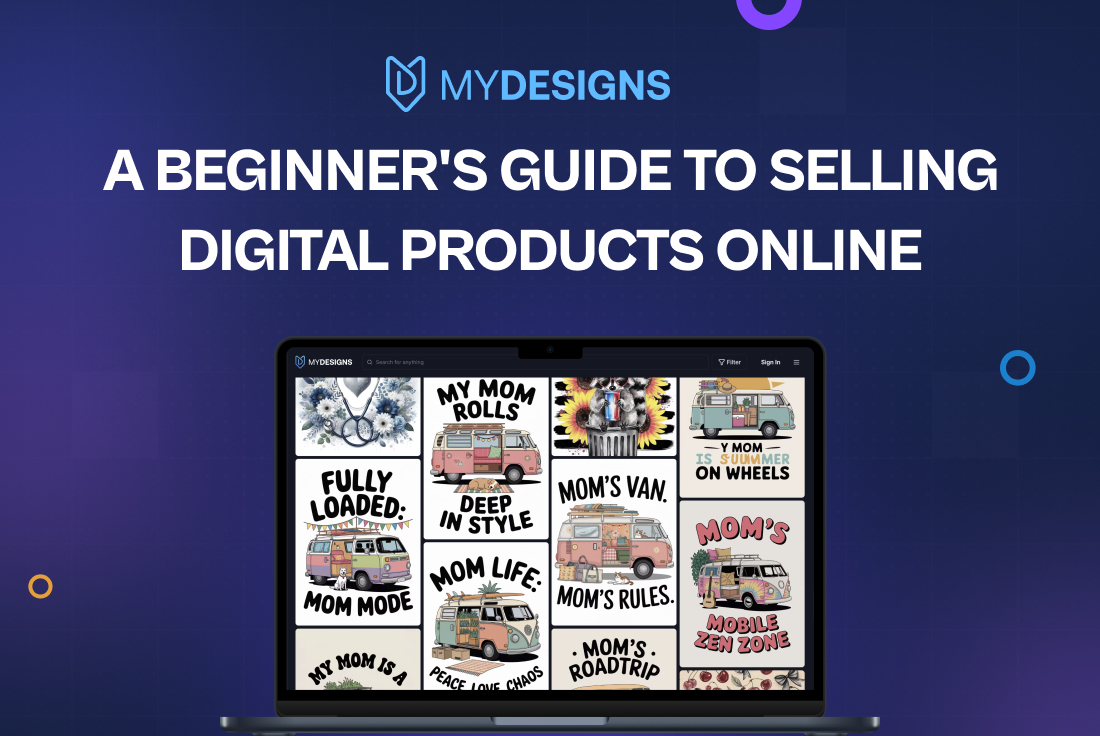
Selling digital products online has never been more accessible and profitable. The rapid digital product and e-commerce market growth, combined with low startup costs and new AI-driven tools, makes 2025 the perfect time to start your digital products business. Whether you’re an artist creating printable wall art or an entrepreneur selling software, this guide will walk you through everything you need to know to succeed in the digital product space.
Table of Contents
What Are Digital Products?
 Digital products are intangible goods that can be sold and delivered electronically. Unlike physical items, customers download or access digital products online. Common examples include:
Digital products are intangible goods that can be sold and delivered electronically. Unlike physical items, customers download or access digital products online. Common examples include:
Printables and Graphics: Printable wall art, planners, stickers, digital papers, fonts, and clip art.
E-books and Publications: PDF guides, e-books, magazines, and digital templates.
Online Courses & Educational Content: Video courses, webinars, tutorials, or worksheets.
Software & Templates: Website themes, mobile apps, graphic design templates, or code snippets.
Audio & Video: Music files, sound effects, stock photos, and stock footage.
Digital products often come as files (PDF, JPEG, MP3, etc.) that buyers download. They may be used for personal projects (e.g., wall art to print at home) or integrated into the buyer’s own business (like using design assets or templates).
Why Sell Digital Products in 2025?
Selling digital products has huge advantages for a new e-commerce entrepreneur. Here are some key benefits driving more sellers to digital goods in 2025:
- Low Overhead: No inventory to store or ship. This means no warehouse fees or worrying about unsold stock. You create a product once and sell it repeatedly without additional production cost.
- Flexibility and Scalability: You can sell unlimited copies of a digital item. Fulfilling an order is as simple as providing a download link. It’s easy to update or fix a digital product at any time (unlike a defective physical item) – just tweak the file and re-upload it.
- Global Reach, 24/7 Sales: Your online store can reach customers worldwide, and sales can happen automatically while you sleep. Buyers get instant access to their purchase, which means instant gratification.
- Passive Income Potential: Because one product can be sold multiple times, digital products enable passive income. Create it once, sell it forever. Many creators earn ongoing revenue from evergreen digital downloads.
Low Startup Costs: You mainly invest your time and skills. If you have a computer and an internet connection, you can start with minimal budget. Many tools for creating and selling (design software, marketplace listings) are free or low-cost.
Popular Digital Product Categories
Not sure what to sell? Here are some of the top digital product categories thriving in 2025:
Printable Art & Stationery
 This includes printable wall art, invitations, planners, calendars, and stickers. Home decor printables (like art prints) are especially popular on Etsy and can be created once and sold many times.
This includes printable wall art, invitations, planners, calendars, and stickers. Home decor printables (like art prints) are especially popular on Etsy and can be created once and sold many times.
Templates & Design Assets
Templates for social media graphics, resumes, business cards, or presentations are in high demand. Creative assets like Procreate brushes, Lightroom presets, icons, and fonts also sell well.
Educational Products
E-books, online courses, study guides, and worksheets. With the e-learning industry surging, well-made educational content can find a large audience.
Professional Resources
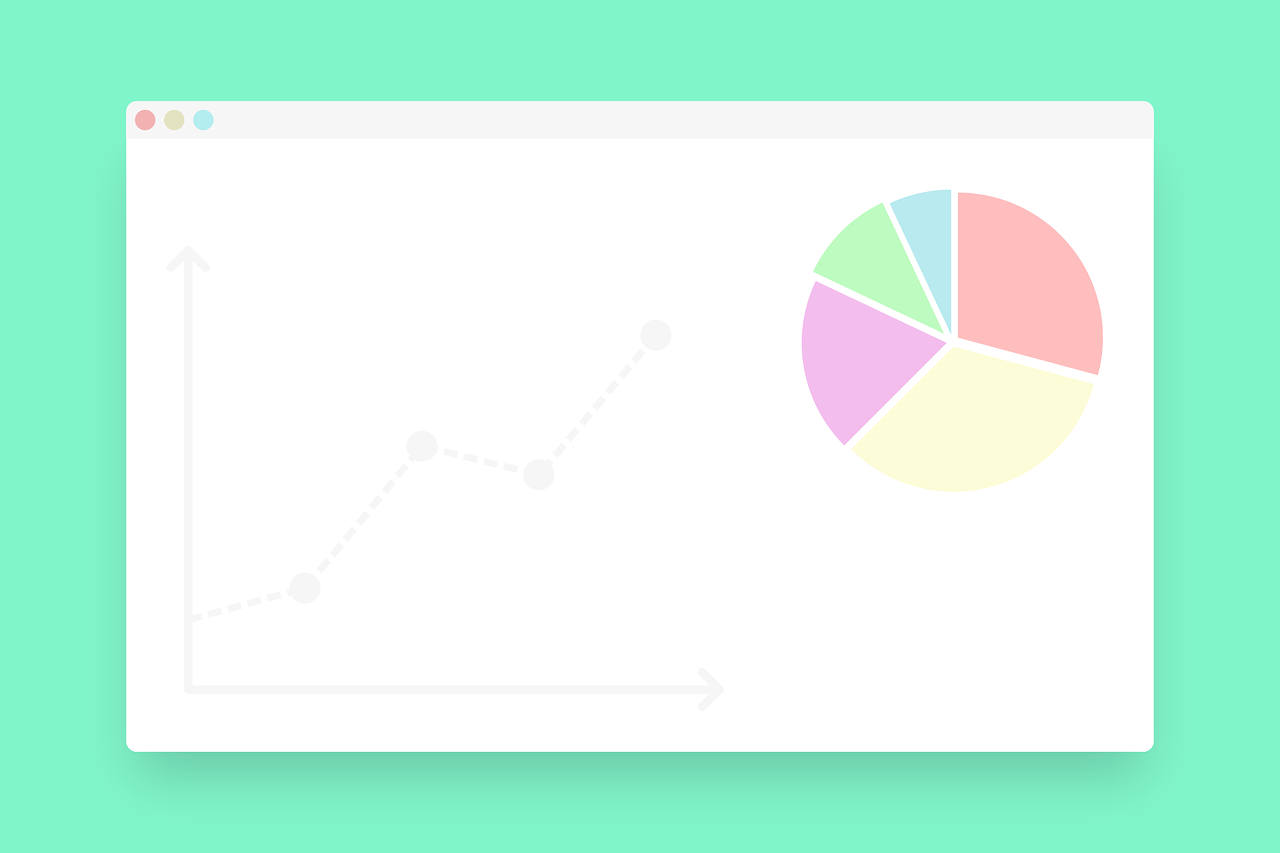 Digital tools for businesses, such as budget spreadsheets, project management templates, or marketing planners. For example, editable budget tracker spreadsheets and to-do list templates are bestsellers for entrepreneurs and organizers.
Digital tools for businesses, such as budget spreadsheets, project management templates, or marketing planners. For example, editable budget tracker spreadsheets and to-do list templates are bestsellers for entrepreneurs and organizers.
Audio/Video & Music
Stock music tracks, sound effect libraries, video transitions, or LUTs for video editing. Content creators and marketers often buy these to enhance their own projects.
Software & Code
This ranges from simple WordPress plugins or website themes to mobile app source code, and even AI prompts or datasets. If you have technical skills, selling code or software licenses can be lucrative.
Do some research on sites like Etsy, Creative Market, or Amazon to see what digital products are trending in your niche. Look for problems you can solve or niches you can serve with a digital download.
Tip: Choose a category that matches your skills and interests. If you’re a graphic designer, templates or printables might be ideal. If you’re a writer, perhaps e-books or guides. Loving your product will help you market it better.
Getting Started: Choose Your Niche and Platform
Pick a Niche
Start with a focused niche so you can stand out. Rather than making a bit of everything, specialize in a category or theme. For example, you might create printable wall art for kids’ rooms or budget spreadsheets for freelancers. A clear niche helps attract a loyal audience looking for those specific products.
Research Demand
Validate your idea by researching keywords and existing products. Search marketplaces (Etsy, Amazon, etc.) to see if similar items are selling and read customer reviews. This will give insight into what customers want and how you can differentiate your product (better design, more features, different style, etc.).
Choose Platforms
Decide where you will sell. Beginners often start on established marketplaces like Etsy because of built-in traffic. Etsy’s marketplace, for instance, can connect you to over 96 million potential buyers searching for products. Other options include Amazon (for e-books, digital games, etc.), Shopify (your own website store), or niche sites like Gumroad or Creative Market. You can also sell on multiple platforms to expand your reach.
Plan Your Branding
Even as a beginner, think about your brand name and product presentation. Consistent branding (shop name, logo, style of product images) helps build trust. Luckily, you don’t need to be a branding expert – simple and clear is a great start.
Choosing the right niche and platform upfront will set a strong foundation for your digital product business. Next, we’ll cover how to create products that shine.
Creating High-Quality Digital Products
Quality matters. With more people selling digital goods, your product needs to stand out. Here’s how to create top-notch digital products:
Use the Right Tools
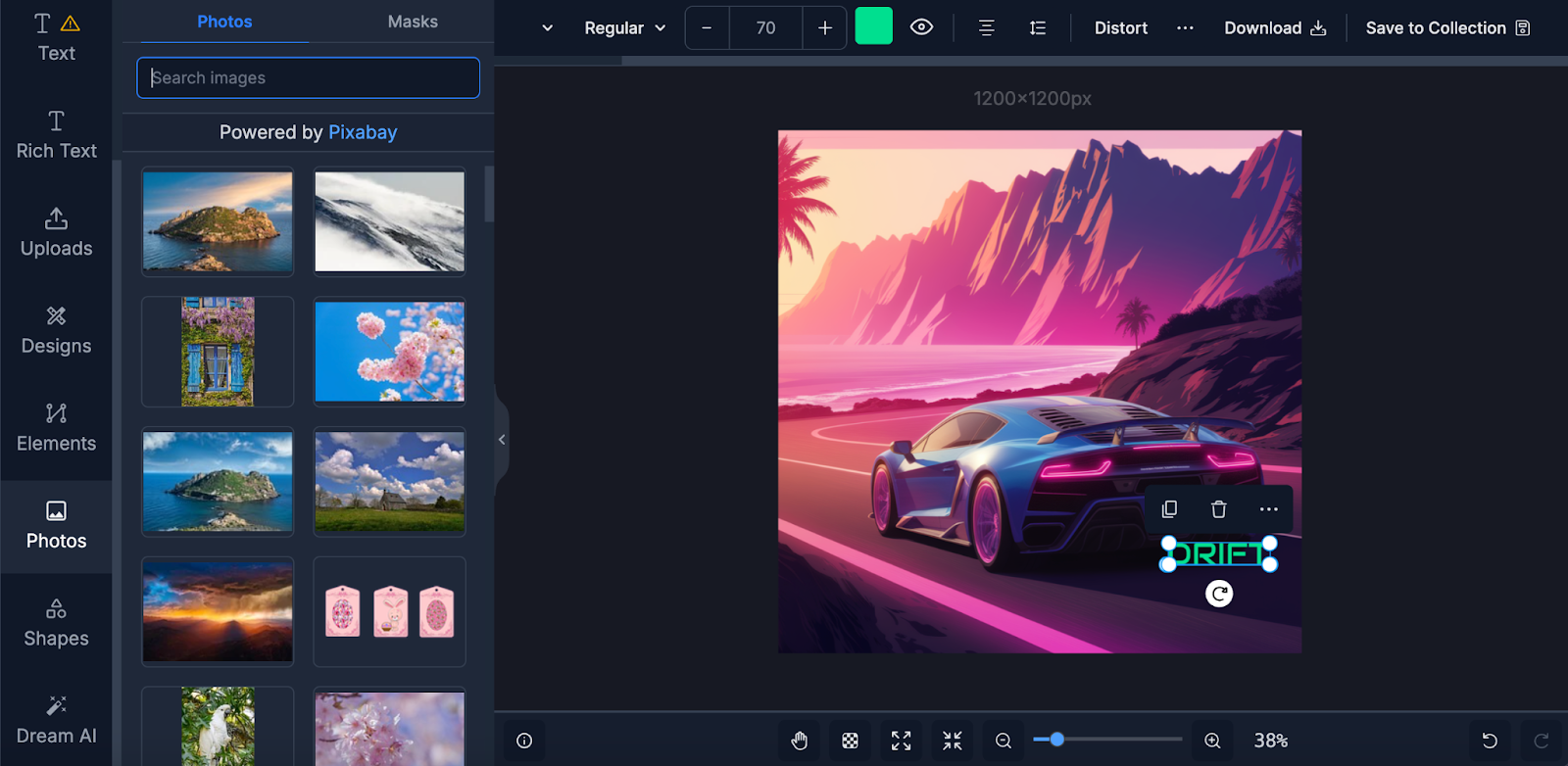 Equip yourself with good creation tools. For visual products, graphic design software is key. Adobe Creative Cloud (Photoshop, Illustrator, etc.) is industry standard for designers. If you prefer a simpler solution, you can design directly in MyDesigns’ Canvas editor (an intuitive drag-and-drop tool for creating designs on MyDesigns). The Canvas tool allows you to build designs with images, text, and shapes easily – no advanced design skills required.
Equip yourself with good creation tools. For visual products, graphic design software is key. Adobe Creative Cloud (Photoshop, Illustrator, etc.) is industry standard for designers. If you prefer a simpler solution, you can design directly in MyDesigns’ Canvas editor (an intuitive drag-and-drop tool for creating designs on MyDesigns). The Canvas tool allows you to build designs with images, text, and shapes easily – no advanced design skills required.
Leverage AI for Creation
 Embrace the new wave of AI creativity. MyDesigns’ Dream AI tool (powered by advanced image generation models) can generate unique art, patterns or illustrations for your products with just a text prompt. This is perfect if you need custom illustrations for, say, printable wall art or social media templates. By describing what you want, Dream AI produces stunning graphics that you can edit and refine.
Embrace the new wave of AI creativity. MyDesigns’ Dream AI tool (powered by advanced image generation models) can generate unique art, patterns or illustrations for your products with just a text prompt. This is perfect if you need custom illustrations for, say, printable wall art or social media templates. By describing what you want, Dream AI produces stunning graphics that you can edit and refine.
Focus on Value and Usability
Make sure your product actually solves a problem or fulfills a need. If you’re creating an ebook or guide, ensure the information is clear, accurate, and valuable. If it’s a template or planner, design it to be user-friendly and visually appealing. Think from the customer’s perspective – what would you want from this product?
Test Your Product
Before listing for sale, test the product thoroughly. For a printable, print it out to see how it looks on paper. For a digital planner, try inputting text to ensure fields are usable. If it’s software, run it on different devices. Fix any issues or errors.
Include Clear Instructions
Many digital products benefit from a short instruction PDF or note for the customer. For example, if you sell Lightroom presets or fonts, include a README file explaining how to install them. This improves customer satisfaction and reduces support questions.
By investing time in creation and using helpful tools (including AI), even beginners can produce professional digital products. High quality products lead to good reviews and repeat customers, setting you up for long-term success.
Best Tools and Resources for Sellers
Running a digital product business can be streamlined with the right tools. Here are some of the best digital products tools and resources for different parts of your workflow:
Design and Creation Tools
For graphics, Adobe Photoshop/Illustrator are powerful (with many tutorials available online). If you’re on a budget, free tools like GIMP or Inkscape can work too. Consider specialized tools for certain products (e.g., Scribus for ebook layout, Audacity for audio editing).
AI Content Generators
Speed up content creation with AI. MyDesigns offers Vision AI and Phraser AI to generate engaging product titles, tags, and descriptions based on your design. This can save hours of brainstorming SEO-friendly descriptions. Beyond MyDesigns, writers might use AI writing assistants (like OpenAI’s ChatGPT) to draft ebook sections or product copy – just be sure to edit for accuracy and personal touch.
Product Mockup Generators
Presentation is key for digital products. Shoppers want to see how the product looks in use. Use tools to create realistic mockup images – for example, MyDesigns’ Product Mockups feature can bulk-generate mockups for things like wall art in frames, t-shirts with your design, or laptop screens displaying your digital download. Quality mockup images can significantly boost conversion rates by helping customers visualize the end result.
Market Research and SEO Tools
To find trending product ideas or popular keywords, use tools like Google Trends, Etsy’s search suggestions, or keyword research tools. Everbee and eRank (for Etsy sellers) can help identify what digital products are hot on Etsy. Use these insights to decide your next product and to optimize your listings with terms people actually search for.
Platform Management Tools
If you plan to sell on multiple platforms (say Etsy and Shopify and Amazon), consider using a management tool like MyDesigns to simplify your workflow. MyDesigns allows you to upload your product once and publish to all integrated marketplaces (Etsy, Shopify, TikTok Shop, WooCommerce, Amazon) with a few clicks – a huge time saver. It also syncs inventory (for POD items) and centralizes orders, so you don’t have to juggle multiple dashboards.
Investing in good tools early can save you time and help you create better products. Many have free tiers or trials, so explore what works for your business. The right tools = more productivity and less headaches.
Where to Sell Your Digital Products
You have a great product – now, where do you sell it? There are two main routes (and you can do both): online marketplaces and your own storefront.
Online Marketplaces
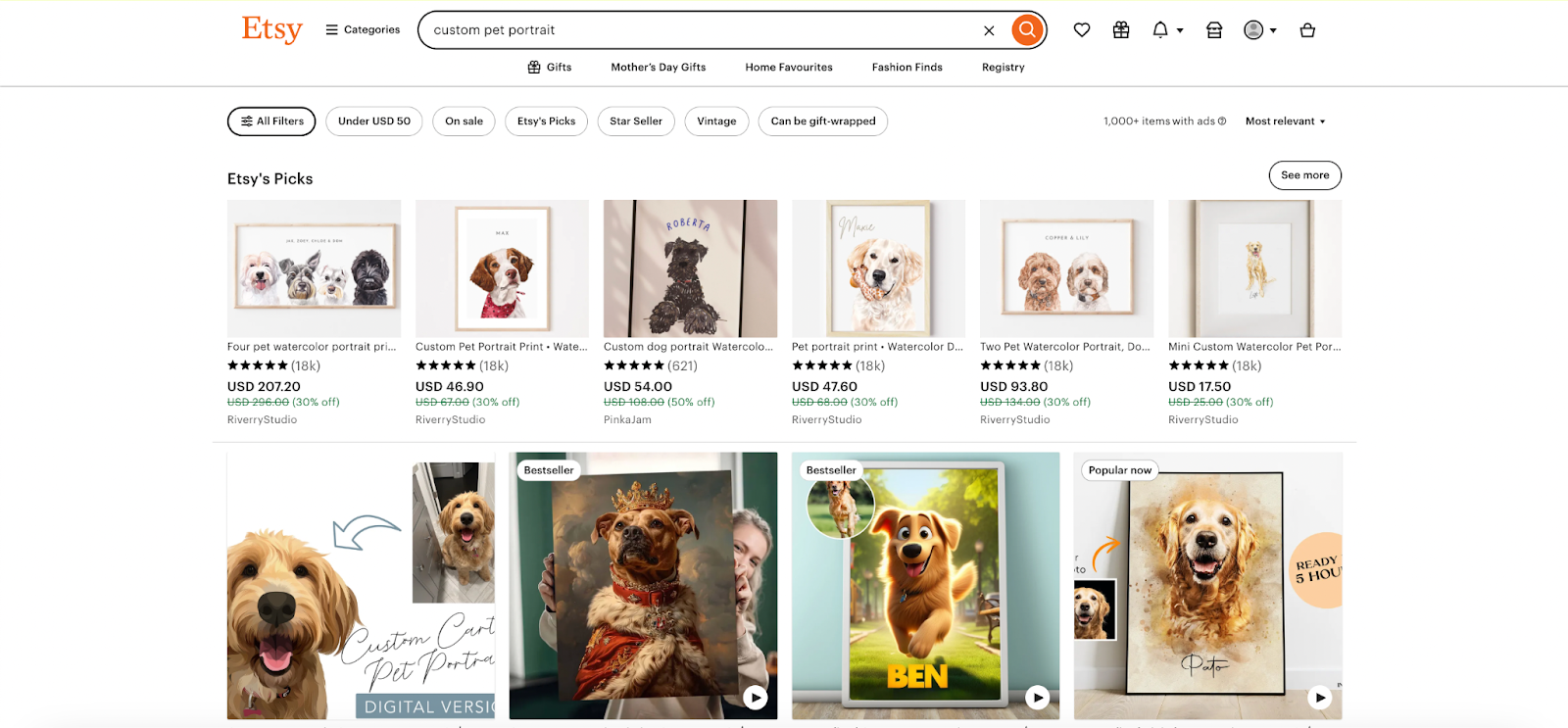
These are platforms where you can list your digital products. For example:
Etsy
Amazon
Creative Market
Gumroad
Envato
Marketplaces come with built-in traffic, which is ideal for beginners with no audience. For example, Etsy is extremely popular for printables and graphics, and many sellers have success with digital products on Etsy’s global platform.
Marketplaces handle payment processing and delivery of digital files for you. However, they do charge fees (listing fees or commission per sale) and you’ll face competition on the same platform.
Pros: Huge audience exposure, easy setup, trust (buyers feel safe on known sites).
Cons: Fees, less control over branding, high competition next to similar products.
Your Own Website/Store
You can create your own digital storefront using third-party store builders. Examples include:
Shopify
WooCommerce
Sellfy
This route gives you full control – you set the design, you have a dedicated site for your brand, and you keep more profit per sale (aside from payment gateway fees). MyDesigns integrates with Shopify and WooCommerce, meaning you can create products in MyDesigns and publish directly to your own website too. If you build a decent following (through social media or email marketing), directing customers to your own site can be very profitable.
Pros: Control over branding, flexible pricing/promos, ability to build an email list of customers for re-marketing.
Cons: You have to drive your own traffic (through marketing/ads/SEO), and there’s a learning curve to set up a website.
Other Channels
Don’t forget social commerce and niche platforms. For example, TikTok Shop is rising in popularity for selling products via short videos – MyDesigns supports publishing to TikTok Shop which could be a great way to reach younger audiences.
You can also sell directly through social media by sharing a link to your product (like a Gumroad link or your website) in your Instagram bio or YouTube description.
Recommendation: Many entrepreneurs start on a marketplace (for quick sales and validation) while gradually building their own site. This way, you get the best of both worlds. Thanks to tools like Multi-Platform Publishing in MyDesigns, you can effectively list once, sell everywhere, maintaining consistent listings across Etsy, Amazon, Shopify, etc.
Optimizing Your Product Listings for More Sales
Simply uploading your product isn’t enough – you need a compelling listing that attracts buyers. Here’s how to optimize your digital product listings for maximum sales:
Title and Keywords
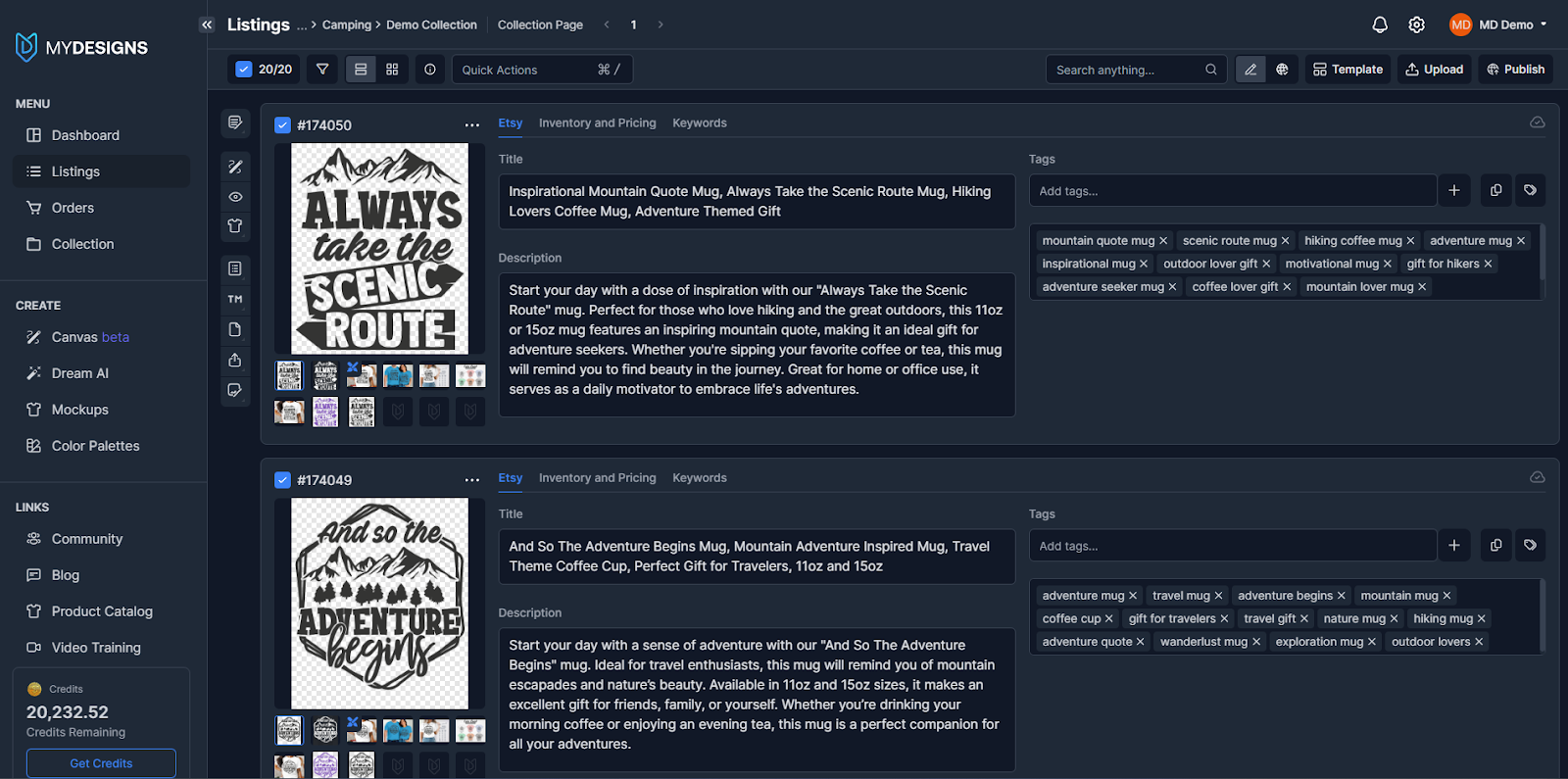 Use clear, descriptive titles with relevant keywords. Think about what a buyer would search. For example, instead of a vague title like “Budget Template 2025,” use “Printable Monthly Budget Planner Spreadsheet (Excel & Google Sheets)” – this hits keywords (printable, budget planner, spreadsheet) and clearly describes the product.
Use clear, descriptive titles with relevant keywords. Think about what a buyer would search. For example, instead of a vague title like “Budget Template 2025,” use “Printable Monthly Budget Planner Spreadsheet (Excel & Google Sheets)” – this hits keywords (printable, budget planner, spreadsheet) and clearly describes the product.
Research keywords using marketplace tools or Google Keyword Planner. MyDesigns’ Vision AI can automatically generate optimized titles and tags for Etsy by analyzing your design, helping you rank higher in search results.
Eye-catching Images
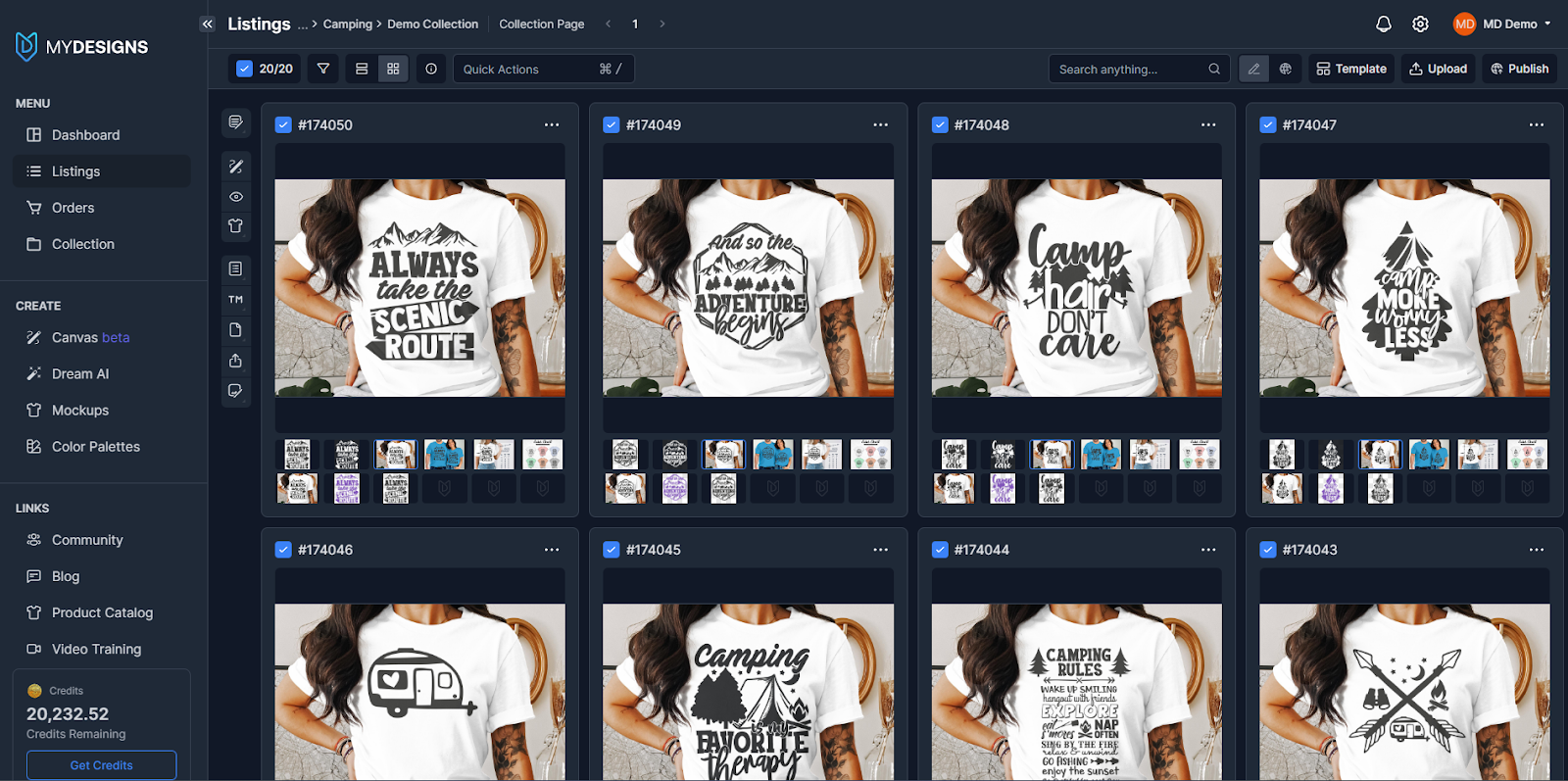 Images are the first thing people see. Include multiple high-quality images that showcase your product. For printables or art, show it in use (frame mockups on a wall, styled desk scene for a planner page). For digital planners or templates, show screenshots of the pages or contents.
Images are the first thing people see. Include multiple high-quality images that showcase your product. For printables or art, show it in use (frame mockups on a wall, styled desk scene for a planner page). For digital planners or templates, show screenshots of the pages or contents.
Use close-ups to highlight details if needed. If selling an ebook, include a 3D book cover mockup. MyDesigns’ product mockup generator is great here – you can create realistic mockups (even lifestyle images) without needing Photoshop.
Detailed Description
Write a clear description that explains what the product is, what the buyer will receive, and how to use it. Highlight the benefits: How will it help the customer? Use bullet points for key features or contents (e.g., “This download includes: 5 PDF files in high resolution 300 DPI, 8×10” size”).
If any software or knowledge is required to use the item, mention that. Keep sentences short and easy to read. Remember, an informed customer is more likely to hit “Buy.”
Pricing Strategy
Research what similar products sell for. Digital products often have a wide range – price too low and customers might assume low quality; price too high and you might deter new buyers. You can experiment with pricing or offer an introductory sale.
Some sellers use tiered pricing (e.g., $5 for a basic version, $12 for an extended bundle with more content). For marketplaces, ending your price with .99 (e.g., $9.99) can psychologically seem more appealing than a round $10.
Encourage Reviews
Social proof helps convert buyers. Encourage satisfied customers to leave a review. You can do this by adding a polite note in your product download (“Thank you for your purchase! If you enjoy this product, please consider leaving a review.”). High ratings will improve your search ranking and attract more buyers.
Optimizing listings might take a bit of extra effort per product, but it pays off with increased visibility and conversions. The good news: many of these steps (like writing descriptions or generating images) can be streamlined with the right tools and templates.
Leveraging AI and Automation in Your Business
One of the reasons it’s exciting to start an online business in 2025 is the plethora of AI and automation tools available. These can give solo entrepreneurs “superpowers” by saving time and improving output quality. Here’s how you can leverage them when selling digital products:
Automate Repetitive Tasks
If you find yourself doing something over and over (like resizing images, creating product variations, or uploading to multiple sites), look for ways to automate it. MyDesigns has bulk listing management, bulk publishing and other bulk features – for instance, you can upload or edit many listings at once, or generate multiple mockups with one click. This bulk approach is a huge time-saver as your product catalog grows.
AI for Content Creation
We touched on design and copywriting AI tools earlier. They can also help with brainstorming new product ideas (e.g., ask an AI for “10 ideas for digital printables for teachers”) or even generating components of your product (like quiz questions for an e-course, or patterns for digital paper). Always review and refine AI-generated content, but use it as a creative assistant to speed up your workflow.
With Dream AI, MyDesigns AI Image Generator, you can generate stunning designs with simple text prompts.
Check out our Dream Library to get inspired.
AI Analytics and Insights
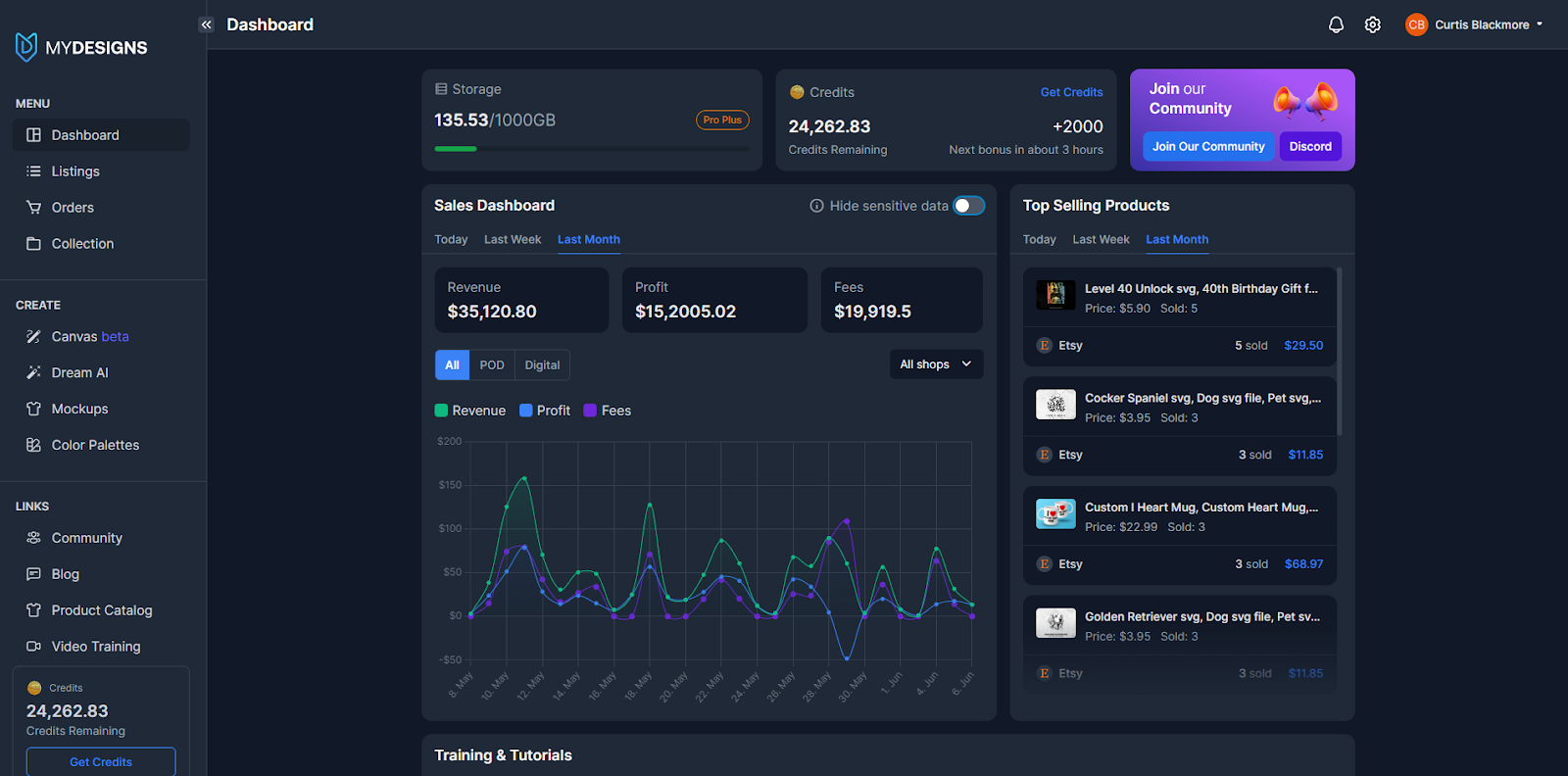 Some advanced tools can analyze your sales data and suggest actions. For example, an AI might identify that “printable wall art” sells better in a certain size or style, prompting you to create more of that. While your operation might not need this from day one, keep an eye on emerging AI analytics for e-commerce. They could help optimize pricing or marketing in the future.
Some advanced tools can analyze your sales data and suggest actions. For example, an AI might identify that “printable wall art” sells better in a certain size or style, prompting you to create more of that. While your operation might not need this from day one, keep an eye on emerging AI analytics for e-commerce. They could help optimize pricing or marketing in the future.
Automated Customer Service
As your sales grow, consider automating parts of customer support. You can set up an FAQ page or automated email responses for common questions (e.g., “Where do I download my files?” or “How do I unzip the product folder?”). Chatbots or simple AI-driven help widgets can guide customers to solutions without you manually intervening every time.
Order and Inventory Management
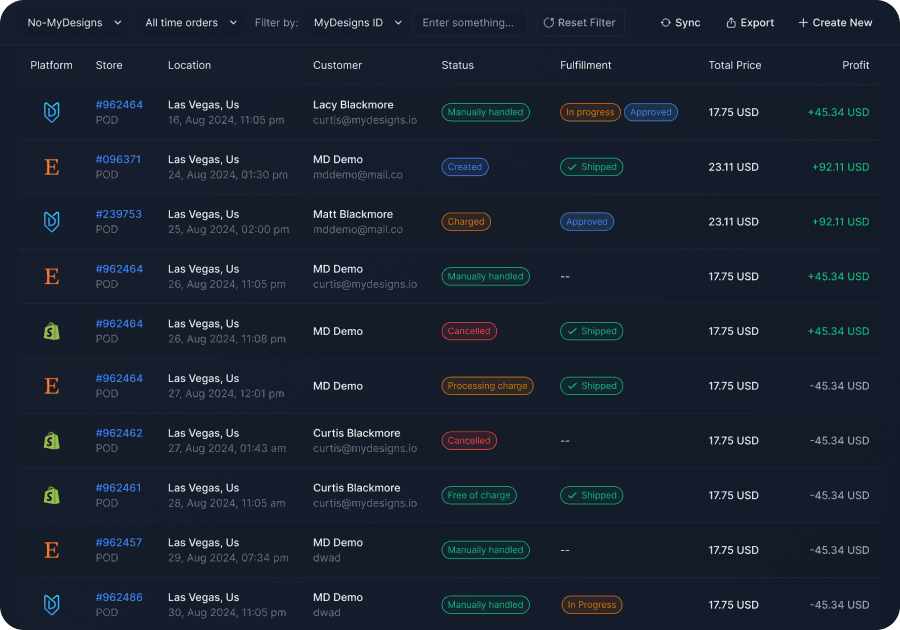 If you expand into print-on-demand products alongside digital (which many sellers do – e.g., offering your art as a physical poster too), automation is crucial for fulfillment. MyDesigns’ Order Management feature ties into your integrated print providers to help you swiftly fulfill orders as they come in. This means when a customer orders a T-shirt with your design on Etsy, the order can be routed to print and ship without you lifting a finger. Even for pure digital sales, a centralized order dashboard helps you keep track of all sales across platforms in one place.
If you expand into print-on-demand products alongside digital (which many sellers do – e.g., offering your art as a physical poster too), automation is crucial for fulfillment. MyDesigns’ Order Management feature ties into your integrated print providers to help you swiftly fulfill orders as they come in. This means when a customer orders a T-shirt with your design on Etsy, the order can be routed to print and ship without you lifting a finger. Even for pure digital sales, a centralized order dashboard helps you keep track of all sales across platforms in one place.
In short, don’t be afraid to use technology to your advantage. Many tasks that used to require a team can now be automated by smart software. This lets you focus more on creative work and strategy rather than administrative chores. Embracing AI and automation will make your online business more efficient and scalable from the start.
Fulfilling Orders and Customer Experience
For digital products, “fulfillment” is usually instant and automatic – a big plus! But you still want to ensure a smooth customer experience after purchase:
Instant Delivery
If you’re using a marketplace like Etsy, the digital files will be provided to the customer immediately after payment. Make sure your files are uploaded correctly and labeled clearly. If selling on your own site, use a platform or plugin that delivers download links instantly via email or account login.
File Organization
Customers should easily understand what they downloaded. Organize multiple files in a ZIP folder with clear names. For example, if you sell a bundle of 10 printables, zip them into one folder named “Floral_Wall_Art_Bundle_ByYourBrand.zip” rather than a random string.
Inside, label files descriptively (e.g., “FloralArt1_8x10inch.jpg”). This professionalism improves user experience.
Support and Communication
Even with a digital product, customers might have questions. Be prompt and courteous in responses. Common issues might be: “I can’t find my download,” “How do I open this file?”, or “Can I get a different size?” Have template answers ready for FAQs, but personalize your response as needed.
Offer Help and Extras
Consider including a thank-you note or a small bonus file with the purchase. For instance, some sellers include a discount code for a future purchase, or a link to a tutorial relevant to the product.
Example: if someone buys your digital planner PDF, you could include a link to a blog post or short video on “best practices for using the planner effectively.” This kind of added value delights customers.
Handling Updates
One cool thing about digital goods – you can improve them even after selling. If you decide to add more content or fix an error, you can update the files and notify past customers (if the platform allows). For example, Etsy lets you send updates to buyers if you upload a new file.
This can turn a one-time product sale into an evolving product that customers appreciate over time (“wow, they gave me a free update with new templates included!”).
Refunds and Licensing
Decide on your refund policy. Many digital product sellers have a no-refund policy (since a customer can’t “return” a digital file), but use discretion – providing a refund in a rare case of an unhappy customer might be worth it for goodwill.
Also, be clear about usage rights in your description or attached terms (especially for design assets: can buyers use it commercially or personal-use only?). Clarity upfront prevents misunderstandings.
By paying attention to these post-purchase details, you’ll build a reputation as a reliable, customer-friendly seller. Even though fulfillment is mostly automated, the human touch in support is what will set you apart and create loyal fans of your brand.
Analyzing Sales and Scaling Up
Once you’ve launched and started making sales, the journey is just beginning. Successful digital product entrepreneurs continually analyze and optimize their business. Here’s how you can scale up:
Track Your Sales Data
Use analytics to understand what’s working. Many platforms provide dashboards with sales numbers, traffic sources, and conversion rates. MyDesigns includes Sales Analytics that aggregate data across platforms, so you can see, for example, that your printable art sells better on Etsy while your e-book does better on Amazon. Identify your best-selling products and focus on expanding those lines or related topics.
Gather Customer Feedback
Pay attention to reviews and messages. Are customers asking for a different format (maybe an A4 size of a printable in addition to 8×10)? Do multiple people suggest a feature that’s missing? Use this feedback to improve existing products or create new ones. Happy customers can also be asked for testimonials if you move to selling on your own site.
Expand Your Product Line
Leverage your hits. If your digital planner is selling well, consider making add-on sticker sheets or an extended version. If your course on one topic did great, think about a follow-up course or an e-book version. You already have buyers who trust you – offer them more value with related products.
Increase Your Reach
Scaling often means reaching new audiences. Consider expanding to additional platforms or channels. For instance, if you started on Etsy, you might create your own Shopify store and drive traffic via content marketing or Pinterest.
Multi-product publishing tools (like those in MyDesigns) make adding new channels easier by reusing your existing product info. Also, invest time in marketing: start a simple blog related to your niche, build an email list with a signup freebie, or engage on social media where your target audience hangs out (Instagram, Pinterest, TikTok, etc., depending on your niche).
Outsource or Automate Further
As profits grow, consider outsourcing repetitive tasks or ones outside your expertise. You could hire a virtual assistant to handle customer emails, or outsource design work for products you envision but can’t create yourself.
Stay Updated and Adapt
The digital landscape evolves quickly. Keep learning about new trends (maybe a new social media platform emerges, or a new type of digital product becomes hot). Subscribe to industry blogs (like HubSpot or e-commerce newsletters) for insights.
In 2025, for example, AI-generated content and NFTs/digital collectibles have been buzzworthy – some sellers incorporated these into their product lines. Be ready to experiment with new ideas that align with your brand.
Scaling a digital product business is an exciting phase – small tweaks can lead to big gains when you’re selling at volume. The key is to remain customer-focused and data-driven. Double down on what works, gracefully fix or phase out what doesn’t, and keep delivering value. Over time, you can grow a side-hustle into a serious income stream or even a full-fledged online enterprise.
Conclusion
Entering the world of selling digital products online in 2025 is a rewarding venture for entrepreneurs who value creativity, flexibility, and innovation. It’s amazing that with just a computer, you can create something once and sell it to people all over the world, over and over again. The combination of low startup costs, high profit margins, and modern tools makes this business model one of the most accessible paths to online income today.
To recap, start by choosing a niche you’re passionate about and do your homework on what customers want. Create quality products (leveraging design tools and AI helpers to punch above your weight), and present them with eye-catching listings optimized for search.
Use marketplaces like Etsy for instant exposure and consider building your own website as you grow. Provide excellent customer service – even digital products benefit from a human connection. Finally, treat your business like a continuous learning process: analyze what sells, listen to feedback, and keep improving and expanding.
Sign up for MyDesigns today to bring your digital products business to life!
Credits
Below are the image sources referenced throughout this article:
Jess Bailey Designs on Pexel,
janjf93 on Pixabay
These sources provided the visual inspiration used to illustrate the design ideas discussed in this article.



Leave a Reply